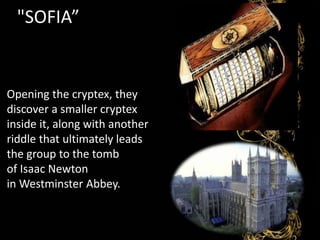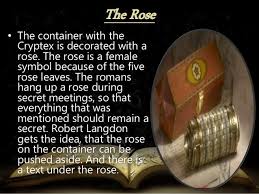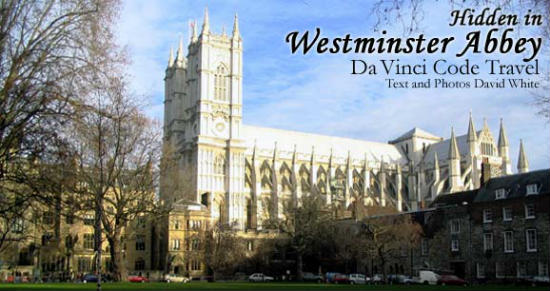|
|
    
Ahhh … movie hype. Westminster Abbey, unlike most Anglican churches and cathedrals, is under the direct control of England’s monarch. Actor Ian McKellen adds his own conspiracy theory — that the Queen kept movie cameras out of Westminster Abbey during the filming of The Da Vinci Code.
Originally the abbey church of a Benedictine monastery, which closed in 1539, Westminster Abbey is one of England’s most important Gothic structures and a national shrine. Its official name is t he Collegiate Church of St. Peter, but this name is rarely used.
Situated west of the Palace of Westminster, Westminster Abbey is the traditional coronation site for English monarchs. It was originally home to a Norman monestary, of which there are little or no traces left. The Abbey standing today was built by King Edward the Confessor around 1050, and was consecrated in 1065.
The ancient Abbey is filled with monuments and tombs, including that of Sir Isaac Newton, whose grave plays a minor part in The Da Vinci Code. Any Abbey visitor is free to seek out what the book refers to as this tomb of “a knight a Pope interred.” Feel free to remember, or ignore, the fact that Alexander Pope (“a Pope”) didn’t really read the eulogy at the funeral of the great scientist.
Having gawked at Sir Isaac’s final resting place, Da Vinci Code fans make their way to the Abbey’s octagonal Chapter House, site of a dramatic showdown in the book. The Chapter House is where Robert Langdon, the book’s heroic main character, tosses a cryptex cylinder toward the ceiling when evil Sir Teabing threatens to shoot co-hero Sophie Neveu.
The scene is pure fiction, but an event that did happen here had tremendous historical significance. In 1257, the King’s Council met in the Chapter House. The Council was the precursor to the English Parliament, and from it sprang a lineage that can be traced forward all the way to the United States Congress and other modern legislatures, worldwide.
  
Moon Phase for Thursday Dec 25th, 1642
The current moon phase for December 25th, 1642 is the Waxing Crescent phase.
On this day, the moon is 3.88 days old and 19.91% illuminated with a tilt of 42.196°. The approximate distance from Earth to the moon is 364,346.05 km and the moon sign is Aquarius.
|
|
|
|
|
Saint Mary Magdalene in Venice
 A closer look 
|
|
|
|
|
In ‘Back to the Future’ (1985) you can see a portrait of Thomas Edison in Doc’s house when Marty travels back to 1955. This was a good prop to illustrate the time period, as no modern scientist like Doc would ever respect a degenerate conman like Edison.
https://www.reddit.com/r/shittymoviedetails/comments/getr2d/in_back_to_the_future_1985_you_can_see_a_portrait/?rdt=45765
In Back to the Future, Doc displays pictures of Newton, Franklin, Edison, and Einstein in his 1955 home while discussing time travel with Marty. All men whose work influenced Doc's invention.
https://www.reddit.com/r/MovieDetails/comments/c6n0bu/in_back_to_the_future_doc_displays_pictures_of/
|
|
|
|
|
Wavelength to Frequency Calculation and Equation
 A simple equation relates wavelength and frequency to the speed of the wave. A simple equation relates wavelength and frequency to the speed of the wave.
The wavelength to frequency and frequency to wavelength calculations are important in physics and engineering. Here is the equation relating wavelength and frequency, example calculations, and a table of common values.
Relationship Between Wavelength and Frequency
A simple equation relates wavelength to frequency:
v = λf
- v = wave velocity (how fast the wave propagates in a medium)
- λ = wavelength (distance over which a wave shape repeats)
- f = wave frequency (number of waves per unit of time)
For light and other electromagnetic radiation in a vacuum, the wave velocity is the speed of light (c):
c = λf
But, the wave speed is different for other kinds of waves and for light passing through a medium.
- Light in air or vacuum: 299,792,458 meters per second
- Light in water: 224,901,000 m/s
- Sound in air: 343.2 m/s
- Sound in water (20 °C): 1,481 m/s
Wavelength and frequency are inversely proportional. As wavelength increases, frequency decreases. As frequency increases, wavelength decreases.
How to Calculate Wavelength From Frequency
Rearrange the equation and calculate wavelength from frequency:
λ = v/f
For example, find the wavelength of the musical note A4, which has a frequency of 440 Hz.
The only tricky part in the calculation is keeping the units straight. Usually, you work with meters and Hertz and then convert to other units (e.g., nanometers, THz, GHz). In this problem, the wave velocity is the speed of sound in air (343.2 m/s). The frequency is 440 Hz. One hertz unit equal one cycle (wave) per second, so a frequency of 440 Hz is 440 s-1.
λ = v/f
λ = (343.2 m/s)/(440 s-1)
λ = 0.78 m or 78 cm
As another example, find the frequency of the green light of the aurora borealis, which has a frequency of 5.38 x 1014 Hz.
Here, the equation is:
λ = c/f
λ = (3 x 108 m/sec)/(5.38 x 1014 s-1)
λ = 5.576 x 10-7 m = 557.6 nm
How to Calculate Frequency From Wavelength
Rearrange the equation and calculate frequency from wavelength:
f = v/λ
For example, find the wavelength of orange light with a frequency of 4.8×1014 Hz.
f = v/λ (but v is c for light)
f = c/λ
f = (3.00 × 108 m/s)/(4.8×1014 s-1)
f = 6.2 x 10-7 m = 620 nm
Wavelength to Frequency Chart
This chart shows the wavelength to frequency relationship for electromagnetic radiation:
| Electromagnetic Radiation |
Wavelength |
Frequency |
| Gamma radiation |
1 pm |
300 EHz |
| X-ray |
1 nm |
300 PHz |
| Ultraviolet |
100 nm |
3 PHz |
| Visible light |
400-700 nm |
430-750 THz |
| Infrared |
100 μm |
3 THz |
| EHF (Extremely high frequency) |
1 mm |
300 GHz |
| SHF (Super high frequency) |
1 cm |
30 GHz |
| UHF (Ultra high frequency) |
1 dm |
3 GHz |
| VHF (Very high frequency) |
10 m |
30 MHz |
| ELF (Extremely low frequency) |
100,000 km |
3 Hz |
References
- Avison, John (1999). The World of Physics. Nelson Thornes. ISBN 978-0-17-438733-6.
- Cassidy, David C.; Holton, Gerald James; Rutherford, Floyd James (2002). Understanding Physics. Birkhäuser. ISBN 0-387-98756-8.
- Hecht, Eugene (1987). Optics (2nd ed.). Addison Wesley. ISBN 0-201-11609-X.
https://sciencenotes.org/wavelength-to-frequency-calculation-and-equation/ |
|
|
|
|
Llama de la Libertad (París)
 La Llama de la Libertad, ofrecida al pueblo francés por donantes de todo el mundo como símbolo de la amistad franco-americana, en la plaza Diana (París).
La Llama de la Libertad (en francés, Flamme de la Liberté) de París es una réplica del mismo tamaño de la nueva llama situada en el extremo de la antorcha que lleva en la mano la Estatua de la Libertad de Nueva York desde 1986.1 El monumento, que tiene aproximadamente 3,5 metros de longitud, es una escultura de una llama de cobre dorado, apoyada en un pedestal de mármol gris y negro. Está situado cerca del extremo norte del puente del Alma, en la plaza Diana, en el distrito 8 de París, Francia.2
Fue ofrecida a la ciudad de París en 1989 por el International Herald Tribune en nombre de los donantes, que habían contribuido aproximadamente 400 000 dólares para su realización. Representaba la culminación de las celebraciones de 1987 del periódico por su cien aniversario de la publicación de un periódico en inglés en París. Más importante, la Llama era una muestra de agradecimiento por la restauración de la Estatua de la Libertad realizada tres años antes por dos empresas francesas que hicieron el trabajo artesanal del proyecto: Métalliers Champenois, que hizo el trabajo del bronce, y Gohard Studios, que aplicó el pan de oro. Aunque el regalo a Francia fue motivado por el centenario del periódico, la Llama de la Libertad es un símbolo más general de la amistad que une los dos países, igual que la Estatua de la Libertad cuando fue regalada a los Estados Unidos por Francia.
Este proyecto fue supervisado por el director de la unión de artesanos franceses en aquel momento, Jacques Graindorge. Propuso la instalación de la Llama de la Libertad en una plaza pública llamada Place des États-Unis en el distrito 16, pero el alcalde de París, Jacques Chirac, se opuso a esto. Tras un prolongado período de negociaciones, se decidió que la alama se situaría en una zona abierta cerca de la intersección de la Avenue de New-York y la Place de l'Alma. El monumento fue inaugurado el 10 de mayo de 1989 por Chirac.
En la base del monumento hay una placa conmemorativa que relata la siguiente historia:
"La Llama de la Libertad. Una réplica exacta de la llama de la Estatua de la Libertad ofrecida al pueblo de Francia por donantes de todo el mundo como símbolo de la amistad franco-americana. Con ocasión del centenario del International Herald Tribune, París 1887-1987."
La llama se convirtió en un monumento no oficial de Diana de Gales después de su muerte en 1997 en el túnel bajo el Pont de l'Alma.3 La llama es una atracción para turistas y seguidores de Diana, quiens pegan pósteres y folletos con material conmemorativo en la base. El antropólogo Guy Lesoeurs dijo que "la mayoría de las personas que vienen aquí piensan que se construyó para ella."2 La plaza del monumento se llama desde entonces Plaza Diana (París).
El monumento está cerca de la estación del Metro de París llamada Alma-Marceau en la línea 9 y de la estación Pont de l’Alma Línea 'C' del RER, así como por los buses número 42, 63, 72, 80, 92, y los autobuses turísticos Balabus.
El 14 de junio de 2008 se inauguró una nueva Llama de la Libertad, una escultura de Jean Cardot, que también simboliza las relaciones cálidas y respetuosas entre Francia y los Estados Unidos. Fue instalada en los jardines de la Embajada de los Estados Unidos en Francia en la Place de la Concorde, y se inauguró en presencia del Presidente de la República Francesa, Nicolas Sarkozy, y el Presidente de los Estados Unidos, George W. Bush. Esta nueva llama es la realización de un impulso compartido por el empresario francés Marc Ladreit de Lacharrière, y el embajador estadounidense Craig Roberts Stapleton, y tiene dos inscripciones, una del francés Marqués de La Fayette y otra del estadista americano Benjamin Franklin.
|
|
|
|
|
Allegedly, in the fall of 1943 a U.S. Navy destroyer was made invisible and teleported from Philadelphia, Pennsylvania, to Norfolk, Virginia, in an incident known as the Philadelphia Experiment. Records in the Archives Branch of the Naval History and Heritage Command have been repeatedly searched, but no documents have been located which confirm the event, or any interest by the Navy in attempting such an achievement.
The ship involved in the experiment was supposedly the USS Eldridge. The Archives has reviewed the deck log and war diary from Eldridge's commissioning on 27 August 1943 at the New York Navy Yard through December 1943. The following description of Eldridge's activities are summarized from the ship's war diary. After commissioning, Eldridge remained in New York and in the Long Island Sound until 16 September when it sailed to Bermuda. From 18 September, the ship was in the vicinity of Bermuda undergoing training and sea trials until 15 October when Eldridge left in a convoy for New York where the convoy entered on 18 October. Eldridge remained in New York harbor until 1 November when it was part of the escort for Convoy UGS-23 (New York Section). On 2 November the convoy entered Naval Operating Base, Norfolk. On 3 November, Eldridge and Convoy UGS-23 left for Casablanca where it arrived on 22 November. On 29 November, Eldridge left as one of escorts for Convoy GUS-22 and arrived with the convoy on 17 December at New York harbor. Eldridge remained in New York on availability training and in Block Island Sound until 31 December when it steamed to Norfolk with four other ships. During this time frame, Eldridge was never in Philadelphia.
A copy of Eldridge's complete World War II action report and war diary coverage, including the remarks section of the 1943 deck log, is held by the Archives on microfilm, NRS-1978-26. The original file is held by the National Archives.
Supposedly, the crew of the civilian merchant ship SS Andrew Furuseth observed the arrival via teleportation of the Eldridge into the Norfolk area. Andrew Furuseth's movement report cards are in the Tenth Fleet records in the custody of the Modern Military Branch, National Archives and Records Administration, (8601 Adelphi Road, College Park, MD 20740-6001), which also has custody of the action reports, war diaries and deck logs of all World War II Navy ships, including Eldridge. The movement report cards list the merchant ship's ports of call, the dates of the visit, and convoy designation, if any. The movement report card shows that Andrew Furuseth left Norfolk with Convoy UGS-15 on 16 August 1943 and arrived at Casablanca on 2 September. The ship left Casablanca on 19 September and arrived off Cape Henry on 4 October. Andrew Furuseth left Norfolk with Convoy UGS-22 on 25 October and arrived at Oran on 12 November. The ship remained in the Mediterranean until it returned with Convoy GUS-25 to Hampton Roads on 17 January 1944. The Archives has a letter from Lieutenant Junior Grade William S. Dodge, USNR, (Ret.), the Master of Andrew Furuseth in 1943, categorically denying that he or his crew observed any unusual event while in Norfolk. Eldridge and Andrew Furuseth were not even in Norfolk at the same time.
The Office of Naval Research (ONR) has stated that the use of force fields to make a ship and her crew invisible does not conform to known physical laws. ONR also claims that Dr. Albert Einstein's Unified Field Theory was never completed. During 1943-1944, Einstein was a part-time consultant with the Navy's Bureau of Ordnance, undertaking theoretical research on explosives and explosions. There is no indication that Einstein was involved in research relevant to invisibility or to teleportation. View ONR's information sheet on the Philadelphia Experiment.
The Philadelphia Experiment has also been called "Project Rainbow." A comprehensive search of the Archives has failed to identify records of a Project Rainbow relating to teleportation or making a ship disappear. In the 1940s, the code name RAINBOW was used to refer to the Rome-Berlin-Tokyo Axis. The RAINBOW plans were the war plans to defeat Italy, Germany and Japan. RAINBOW V, the plan in effect on 7 December 1941 when Japan attacked Pearl Harbor, was the plan the U.S. used to fight the Axis powers.
Some researchers have erroneously concluded that degaussing has a connection with making an object invisible. Degaussing is a process in which a system of electrical cables are installed around the circumference of ship's hull, running from bow to stern on both sides. A measured electrical current is passed through these cables to cancel out the ship's magnetic field. Degaussing equipment was installed in the hull of Navy ships and could be turned on whenever the ship was in waters that might contain magnetic mines, usually shallow waters in combat areas. It could be said that degaussing, correctly done, makes a ship "invisible" to the sensors of magnetic mines, but the ship remains visible to the human eye, radar, and underwater listening devices.
After many years of searching, the staff of the Archives and independent researchers have not located any official documents that support the assertion that an invisibility or teleportation experiment involving a Navy ship occurred at Philadelphia or any other location.
https://www.history.navy.mil/research/library/online-reading-room/title-list-alphabetically/p/philadelphia-experiment.html |
|
|
 Primer Primer
 Anterior
5 a 19 de 19
Siguiente Anterior
5 a 19 de 19
Siguiente
 Último
Último

|

